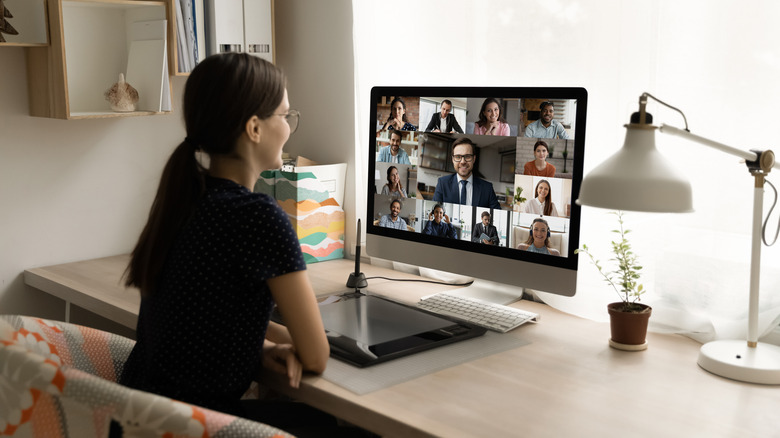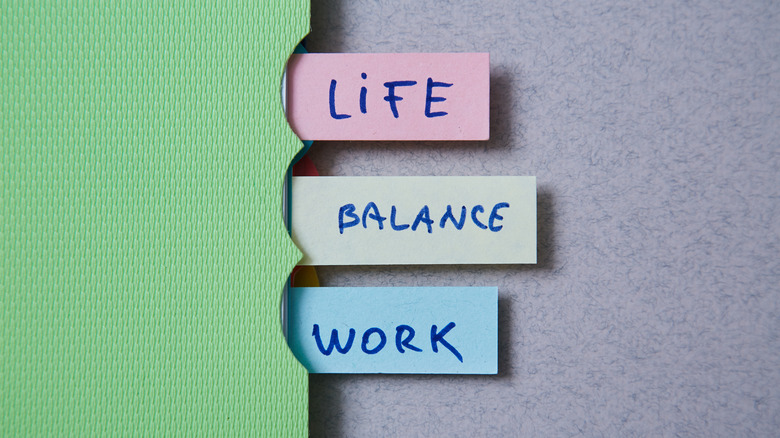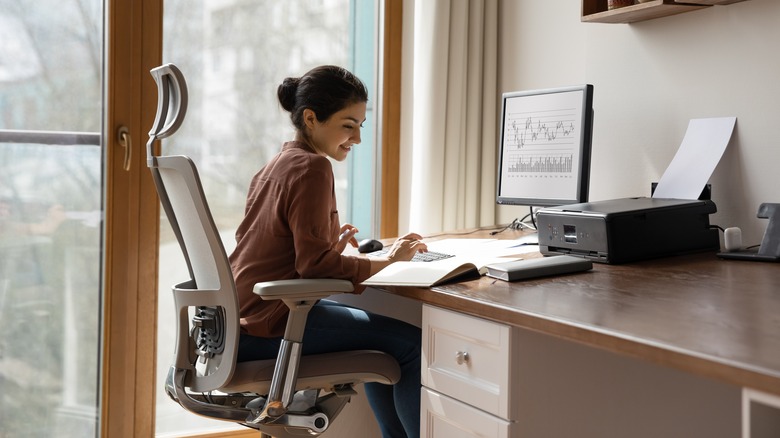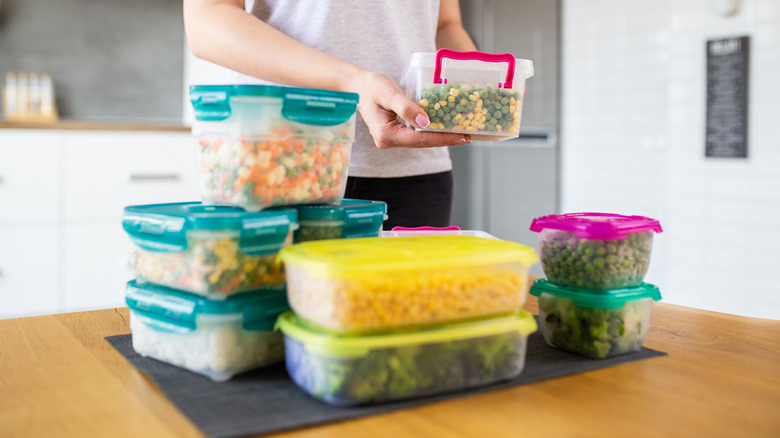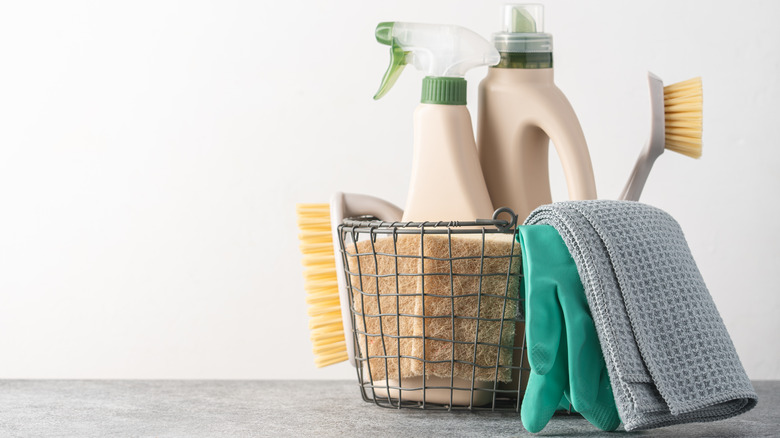How To Create A Routine And Eliminate Stress When Working From Home
When you work from home, you aren't just managing work every day. You're managing life. The reality is, as much as you may try to ignore it, it's hard to only focus on your job and imagine the needs of the home aren't there. Stress can mount if you don't take action to create a routine when working from home.
Stress is often a part of work, unfortunately, and when working remotely, you can feel alone in your anxiety and burnout. It's important to taper stress in your life as much as possible. It's often unavoidable, but if we can eliminate the negative things that we can control, it's a start. WebMD tells their readers that stress plays a role in leading to headaches, high blood pressure, anxiety, asthma, arthritis, diabetes, skin issues, and depression. It's even declared a hazard in the workplace, by OSHA (Occupational Safety and Health Administration).
It's time to take stress seriously. If you work from home, you have more control over your workplace atmosphere. In this article, we'll discuss some things you can do to help you balance home life and work when you work from home.
Schedule everything you can
There may not be a more important or helpful tool to help you create a routine when working from home, than a schedule. You can make a schedule as full, strict, or flexible as you need it to be. Schedules vary depending on who is a part of them and what needs to get done.
If you have a family and want to get the kids involved, Harvard Business Review suggests you agree as a family about how events are added to the calendar. If children are old enough, can they add their own events? Also, meet with your partner once a week to discuss the schedule and make sure nothing is missed. Decide what you want on the schedule.
Does the entire family need to know what time you have meetings scheduled, so they know not to interrupt? Or would you prefer your work schedule to be completely separate from the family's? Either way, you need a work schedule to help you meet your career goals throughout the day. One option is to keep that separate, in your work area or on your phone, and then just include blocks of time on the family schedule that let everyone know you're working during that time.
Some individuals and families like an electronic schedule, while others prefer a big, colorful schedule, hung on the wall so it's seen often. It may be helpful to do both.
Set your alarm clock
Not your phone – an actual alarm clock. When you use your phone to wake you up, you're allowing your phone to be the first thing you grab or look at each morning. According to Personal Growth Lab on Medium, grabbing your phone first thing increases anxiety and stress, hijacks your time and attention, and sets a distracting tone for the day. Yuck. You may want to rethink your phone habits if you are reaching for yours as soon as you wake up. Instead, get an old-fashioned alarm clock that beeps, sings, or buzzes at you to get you out of bed. Whatever you choose, alarm clocks are good for you.
Early Bird by Amerisleep informs us that alarm clocks benefit our internal clocks and help us to normalize our sleep schedules. They keep us on track and train our minds to wake up at the same time every day. That's beneficial for your home life and for work. Getting an early start can help you accomplish everything you hope to in a day.
When it comes to setting alarms, there are two kinds of people: those who hit snooze and those who don't. Which one are you? If snoozing is your bad habit, you may need to take drastic action, such as setting your alarm out of reach, so you have to get up to shut it off. You may feel pretty annoyed when it happens, but after getting used to jumping out of bed to silence the annoying alarm, you also might be glad your day is starting on time.
Designate an exercise area
Your health is important, so don't forget to exercise. Create a designated area to make it happen. It may be as simple as a small spot with a yoga mat. Just put whatever you need in that area to motivate you every day. Gym memberships are great, but the trip to the gym takes up time and on those days you end up stuck at home, you need backup. Lots of people like to exercise first thing in the morning, but only you know the best time of day for yourself. If the end of the day is more enticing, then make that your fitness time.
By now, we all know fitness is important for our health, but how much exercise do we really need? Mayo Clinic states that we need at least 150 minutes of moderate aerobic activity or 75 minutes of vigorous aerobic activity per week. It's also good to include strength training for each muscle group, at least twice a week. All that said, a break to exercise or exercising first thing in the morning will help keep your stress level down and give you a feeling of accomplishment for the workday.
Where do you think you're more likely to get your exercise done? The bedroom? The basement? Or maybe right in the living room where all the action is? Choose the items you need, such as an exercise machine, mats, bands, and weights for your exercise area. Add a speaker and make a playlist to get you moving. A laptop or smart TV is handy for streaming exercise videos. Move every day and include exercise in your daily schedule.
Create a home office space
You need a place to get your work done with few to no interruptions. A home office space doesn't have to be an entire room. MHM Professional Staging has a few ideas for creating an office at home when you don't have a room for one. Consider the family room, the kitchen, a closet, a loft area, the living room, or the dining room. You may need to get creative in these areas, but if you think outside the box, you'd be surprised how little space you need to get your job done at home.
The first place to start is with a desk or at least an area, (like a table) designated for your computer. Find a corner in a room or clear a spot in your closet where you can stick a desk. To save more space, there are desks that fold out of shelves, making them multifunctional pieces of furniture. Are any of the rooms in your home not in use, or is there a room that has become the place where you put everything that doesn't have a home? Rooms, like a formal dining room, often sit unused, even though they're covered in odds and ends. You may be able to clear out a room like that and use it or part of that space for your office.
When your office is at home it's important to discuss with the family what your work hours are. This is especially helpful when kids want answers to questions. Have a code you use to let them know when it's okay to make noise or talk to you and also when they need to wait. For little ones you can hang a red piece of construction paper, reminding them that it's like a red light – you have to stop and wait. Then use green for when there isn't a Zoom meeting or phone call and you're available. Interruptions are a part of working at home, but you can find ways to designate work hours and a workspace.
Organize your desk
Even if you aren't naturally neat and tidy, an organized work area will help you to focus. At least once a week, go through all the piles of papers and clear off what doesn't need to be there. Clutter is distracting and you may not perform as well at your job when surrounded by it. News GP tells its readers that clutter affects anxiety levels, our ability to focus, and our sleep. Research by Science Direct says there is evidence that work environments affect employees' well-being and job performance. No matter where you're working, even if it's at home, your environment is affecting you.
Once the desk is clear, give it a cleaning with a damp rag. Invest in a desk organizer or use containers from around the house to keep things in order. Little things like paper clips and post-it notes need something to contain them or they scatter all over. If you have piles of paper on your desk, maybe it's time for a filing system.
Jars or a glass from the kitchen can hold your pens and pencils. It doesn't have to be fancy or high-tech. Just do what you can to give everything on your desk a special place and return it there after use. Keep a waste can by your desk for garbage and another one for all the paper so you can recycle it. Declutter your space and you'll declutter your mind.
Prepare meals and stock the fridge
One of the toughest parts of working full-time is managing mealtime at home. When working at home, the temptation to interrupt the workday and cook might cause problems with your production. Plan and prepare food ahead of time so there are meals ready to go. You can do this by taking a day when you're not working, such as on the weekend, and scheduling it for meal prep. Plan a menu and get the shopping done ahead of time. Consider crockpot meals that are dumped into the slow cooker in the morning and done just in time for dinner. Money Crashers points out that crockpot meals save time, are faster to clean up, they're energy-efficient, and offer the ability to make low-cost meals.
Things to consider for the weekly menu are snacks, breakfast, lunch, and dinner. Doing this can help you to eat a little healthier if planned well. Sometimes, the reason we eat junk food is that it's already prepared. On meal prep day, spend your (and your helpers) time chopping, slicing, dicing, and cooking as needed. Then, you'll need to store everything in containers in the refrigerator or freezer, depending on what it is and how long it takes to spoil. Some meals can be placed in freezer-safe plastic slider storage bags and laid flat to freeze. This way, they take up little space in the freezer.
You can stack frozen chili, soups, chicken breasts, and just about anything right on top of each other or stand them up, side by side, after freezing. According to the USDA, you can freeze just about any food. However, not every food is in good condition once defrosted. Avoid freezing mayonnaise, cream sauces, and lettuce.
Label your containers if it's helpful. You may want to go as far as labeling breakfast, a couple of snacks, lunch, and dinner, with a day of the week. Do whatever works for you to feel organized and set for the work week. Planning ahead and knowing you'll be able to grab and prepare meals quickly means it's one less thing to think about while doing your job.
Narrow down cleaning supplies
Just like mealtime, cleaning the house can be a huge distraction when working remotely. You have two choices: either don't allow cleaning until after work or use your break times to get some cleaning done. It takes discipline to make yourself take the breaks you need while working remotely. After all, if you never leave your computer, you can get more work done. But can you? The Harvard Business Review mentions that extended periods of time on our screens cause headaches, eye pain, blurred vision, itchy, tired eyes, and trouble keeping our eyes open. That's not a formula for a productive workday. Get up and get away from your desk and computer as much as possible for your health and your eyes.
Keeping cleaning supplies ready to go gives you something physical to do when you take a 15-minute break. You don't have to clean the whole house, but you can quickly clean the powder room in 10 minutes, forget about work, stay standing, and accomplish a household task, relieving some stress. To keep supplies accessible and manageable, grab a basket or bin with a handle that you can easily carry from room to room.
Fill it with an all-purpose spray cleaner, a toilet bowl cleaner, and some glass cleaner. That's all you need. You can even keep these items in each bathroom to make it easier. Always have two clean rags ready to go in your cleaning basket. One is for cleaning and one is for drying and shining. Also, keep a roll of paper towels to clean the bathroom mirrors.
You don't need a dozen cleaning agents to clean your bathrooms or even your home. Narrow down supplies (which reduces clutter), organize your cleaning things into one basket, and during work breaks, give something a cleaning – physical movement, no thoughts of work, and a chore scratched off the list.
Noise or no noise?
Some of us need a little background noise and others appreciate the sounds of silence. It may take some trial and error to find out what works for you. If you're the silent type, keep that in mind when choosing where your home office space will be. A door may be essential. You can also try headphones or ear plugs if necessary. If silence is deafening to you, a sound machine, a constant fan, or classical music in the background might help you to be more productive. For some people, the silence just draws attention to every little, unexpected noise.
In an article about background music and sounds, Effectiviology writes that listening to background noise or music while working leads to benefits such as greater task performance, improved cognitive performance, better concentration, higher energy levels, and a better mood. If you've never tried a little background noise while working from home, you may want to give it a go and see what you think.
Keep lists everywhere
Back in the 1980's the Go-Go's had a song titled, "Girl of 100 Lists." Working from home, that's who you should become. Okay, maybe not a hundred, but you get the idea. Trusting our minds to keep our to-dos in order doesn't always go so well. They often get filed into some secure vault, never to be seen again. You may find yourself standing in the middle of the grocery store thinking, "What was it I wanted to get?" You aren't losing it; life is just busy and you have lots to remember. There's something about writing things down. Once it's there, we no longer have to think about it, because our list will remind us. To-do lists create order in our lives, they help us to designate jobs, keep us accountable, and help relieve stress, Lifehack tells us. Make yours however you like. Some people enjoy a little box they can scratch off or drawing a line through each task as it's complete.
Place a clipboard or notepad in areas where you often wish you had a piece of paper to jot down something that needs to get done or purchased. A list isn't a schedule. It's a note that reminds you of things to add to the schedule or things the household needs, whether it's for work or for the family. A list near the bathrooms is helpful when there isn't any toothpaste left. Even a child can write "toothpaste" on the list. A clipboard or markerboard hanging in the kitchen helps you when grocery shopping. When you get home the kids won't point out everything they wish you would have gotten. They can add it to the list all week.
When you're in the middle of a meeting and the need to see a dentist pops into your head, jot down dentist on your to-do list. Make lists work for you so you can relieve yourself of the worry you'll forget something.
Comfort your senses
In your workspace at home, pay attention to your senses. What sights, sounds, and smells make you feel relaxed or motivated? Just like background noise, certain aromas and visuals can encourage and motivate us or do just the opposite. For example, do you enjoy a lightly scented, burning candle in your home? If so, keep one in your office area.
What are your eyes looking at when you sit back from the computer? Hopefully, not a blank wall. Consider a houseplant or two. Plants offer a relaxing vibe and bring some nature into our workspace. The Sill reminds us that plants aren't just decorative things that make us feel good. They're actually good for our environment as well and can improve the air in your office. They do so by absorbing carbon dioxide and releasing oxygen.
If you're an art lover, arranging a small collection of your favorite pieces near your desk will complete your décor. Or maybe it's a family portrait that keeps you motivated. Whatever brings you peace and comfort, include it in your at-home office. Our senses keep us aware of our surroundings, so make sure you are catering to yours while you work.
